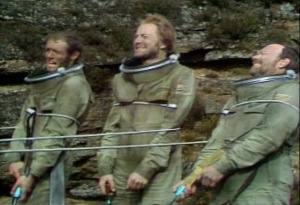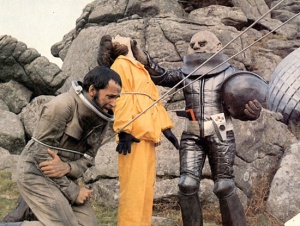The Sontaran Stratagem harkens back to the old 1970s Doctor Who serials, not just because it re-uses the titular villains but because the whole set-up is like something Jon Pertwee would have been involved in, having to begrudgingly get along with the military (UNIT) while temporarily trapped on Earth. It even features human workmen who become possessed and/or cloned, which was a regular staple of the old serials, probably because it was cheap. Thankfully, the Sontarans themselves look a lot better than the old rubbery masks, but they’re still very much the same villains.
In later series, the Sontarans will become the comic relief, particularly the Doctor’s friend Strax, with his casually violent remarks and failure to understand human ways, but these Sontarans are still the threatening military force that they once were, treating humans as pests to be eradicated. They only know of war and glory, it’s all they live for. This should make them boring, but it doesn’t; however, it needs a tragic angle to give it depth, and that’s where Luke Rattigan comes in. Tricked by the Sontarans, this naive young genius is the equivalent of what would have been some jaded old company director in a Jon Pertwee episode, working with the enemy for his own goals. It does highlight some of the differences between then and now.
For instance, back then, the (third) Doctor wasn’t a famous figure revered throughout the galaxy. The aliens or other forces he faced didn’t know him, and he often didn’t know them either. And although the world was put in danger, whether by volcanic eruption, invasion by dinosaurs, or assault by Autons, the world at large didn’t see any of it happen. Conversely, the modern series is absolutely obsessed with the whole wide world being put through horrible things without stopping to think about the impact it ought to have. Every time they do one of those news report montages telling us it’s the end of the world, I just cringe. How many times can it really be the end of the world? It’s utterly incongruous with other characters’ continued insistence that there’s no such thing as aliens, but more importantly, it’s just boring. There is no impact anymore; there is no greater threat. The Doctor can stand there on a planet that’s about to be killed with toxic gas, but I just won’t believe it’s going to happen. He’ll wave his sonic screwdriver around and everything will be fine again.
So, this two-parter is a mix of some good old-school set-ups with some bad new-school wrap-ups. It’s not as good as it could be, but it’s not too bad either. The Sontarans are just about right (war chanting aside), the script is often sharp and funny, Donna continues to impress as a companion, it’s nice to see Martha again, although she’s so bland that you can’t actually tell when it’s the clone version on screen (or maybe that’s the point), and the throwbacks to the Doctor’s past with UNIT are a nice touch (particularly that he can’t remember if he worked for them in the 70s or 80s!). But there is just too much screwdriving this and deadlocking that, winning with technobabble yet again, and everyone is fine and happy and going about their normal lives after the ordeal is over. It’s grandiose and overblown because it has the technology to do it now, but that doesn’t mean it should.




















